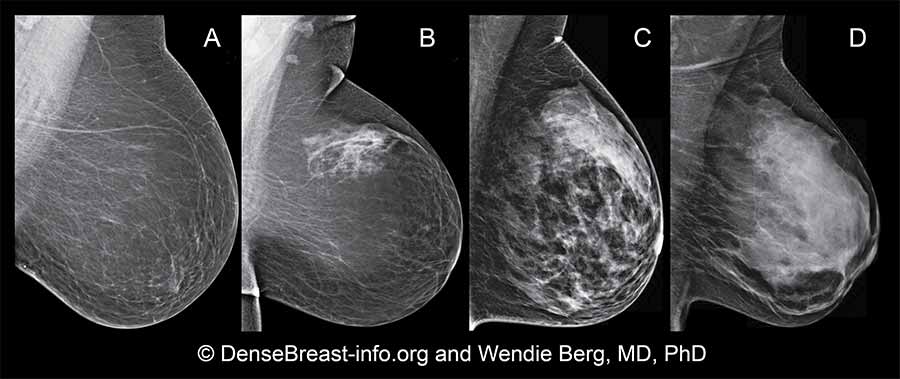02/20/2018 11:26 AM EST |
Dense Breasts: Answers to Commonly Asked Questions
What are dense breasts?
Breasts contain glandular, connective, and fat tissue. Breast density is a term that describes the relative amount of these different types of breast tissue as seen on a mammogram. Dense breasts have relatively high amounts of glandular tissue and fibrous connective tissue and relatively low amounts of fatty breast tissue.
How do I know if I have dense breasts?
Only a mammogram can show if a woman has dense breasts. Dense breast tissue cannot be felt in a clinical breast exam or in a breast self-exam. For this reason, dense breasts are sometimes referred to as mammographically dense breasts.
How common are dense breasts?
Nearly half of all women age 40 and older who get mammograms are found to have dense breasts. Breast density is often inherited, but other factors can influence it. Factors associated with lower breast density include increasing age, having children, and using tamoxifen. Factors associated with higher breast density include using postmenopausal hormone replacement therapy and having a low body mass index.
How is breast density categorized?
Doctors use the Breast Imaging Reporting and Data System, called BI-RADS, to group different types of breast density. This system, developed by the American College of Radiology, helps doctors to interpret and report back mammogram findings. Doctors who review mammograms are called radiologists. BI-RADS classifies breast density into four categories, as follows:
- (A) Almost entirely fatty breast tissue, found in about 10% of women
- (B) Scattered areas of dense glandular tissue and fibrous connective tissue (scattered fibroglandular breast tissue) found in about 40% of women
- (C) Heterogeneously dense breast tissue with many areas of glandular tissue and fibrous connective tissue, found in about 40% of women
- (D) Extremely dense breast tissue, found in about 10% of women
If you are told that you have dense breasts, it means that you have either “heterogeneously dense” (C) or “extremely dense” (D) breasts.
Does having dense breast tissue affect a woman’s mammogram?
Dense breast tissue appears white on a mammogram, as do some abnormal breast changes, such as calcifications and tumors. This can make a mammogram harder to read and may make it more difficult to find breast cancer in women with dense breasts. Women with dense breasts may be called back for follow-up tests more often than women with fatty breasts.
Are dense breasts a risk factor for breast cancer?
Yes, women with dense breasts have a higher risk of breast cancer than women with fatty breasts, and the risk increases with increasing breast density. This increased risk is separate from the effect of dense breasts on the ability to read a mammogram.
Are breast cancer patients with dense breasts more likely to die from breast cancer?
No. Research has found that breast cancer patients who have dense breasts are no more likely to die from breast cancer than breast cancer patients who have fatty breasts, after accounting for other health factors and tumor characteristics.
Should women with dense breasts have additional screening for breast cancer?
In some states, mammography providers are required to inform women who have a mammogram about breast density in general or about whether they have dense breasts. Many states now require that women with dense breasts be covered by insurance for supplemental imaging tests. A United States map showing information about specific state legislation is available from DenseBreast-info.org.
Nevertheless, the value of supplemental, or additional, screening tests such as ultrasoundor MRI for women with dense breasts is not yet clear, according to the Final Recommendation Statement on Breast Cancer Screening by the United States Preventive Services Task Force. Ongoing clinical trials are evaluating the role of supplemental imaging tests in women with dense breasts. NCI’s Contact Center can tell you about clinical trials and provide tailored clinical trial searches to help you learn more about clinical trials related to breast density and breast cancer screening.
Recent research has suggested that for women with dense breasts, a screening strategy that also takes into account a woman’s risk factors and protective factors may be the best predictor of whether a woman will develop breast cancer after a normal mammogram and before her next scheduled mammogram.
As you talk with your doctor about your personal risk for breast cancer, keep in mind that:
- risk factors increase your chance of breast cancer
- protective factors lower your chance of breast cancer
NCI’s PDQ® summary for Breast Cancer Prevention includes a section that lists risk factors and protective factors for breast cancer.
It may help to ask your doctor these questions, to put your risk for breast cancer into context:
- What are the findings of my recent mammogram?
- Are other additional screening or diagnostic tests recommended?
- What are my personal risk factors for breast cancer? Protective factors for breast cancer?
- What steps can I take to lower my risk of breast cancer?
What are researchers hoping to learn about the relationship between breast density and breast cancer?
Some important questions include:
- Can imaging tests such as 3-D mammography (breast tomosynthesis), MRI, and ultrasound help provide a clearer picture of breast density?
- Are there certain patterns or areas of dense breast tissue that are particularly “risky”?
- Why do some women with dense breasts go on to develop breast cancer, while others do not? Can biomarkers be identified that help predict whether breast cancer will develop in a woman with dense breasts?
- Are changes in breast density over time associated with changes in breast cancer risk?
You can read more about research in this area in Exploring the Relationship Between Mammographic Breast Density and Breast Cancer from NCI’s Division of Cancer Epidemiology and Genetics (DCEG). DCEG research covers a range of risk factors for cancer, including breast density, based on issues identified through epidemiologic, clinical, and laboratory observations, as well as public health concerns.
























.png)












No hay comentarios:
Publicar un comentario